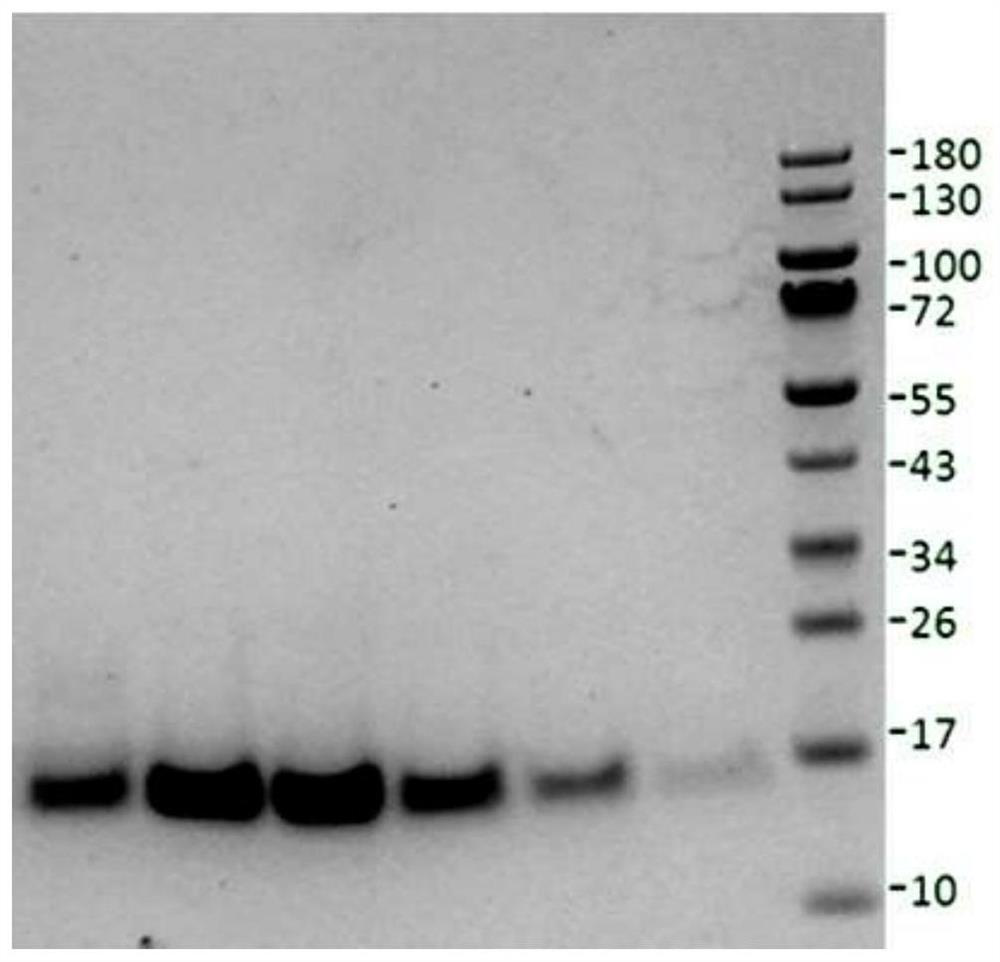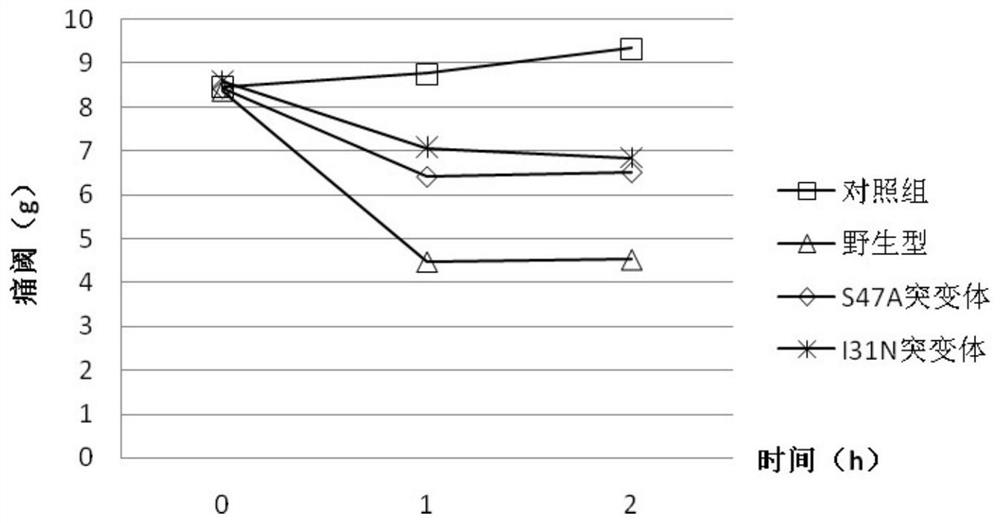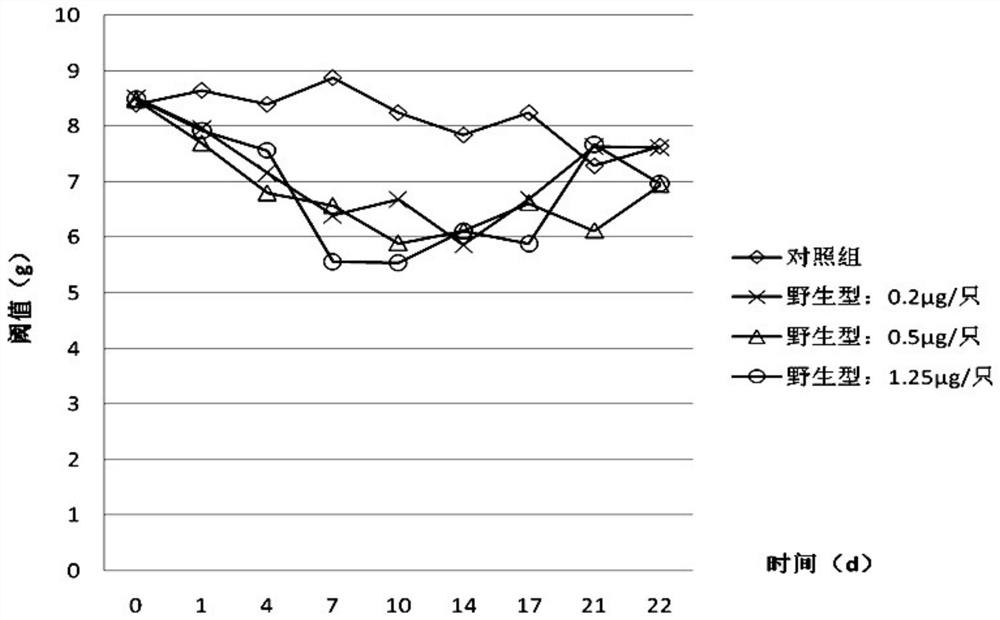low pain NGF mutant
A nerve growth factor, mutant technology, applied in the field of biopharmaceuticals, can solve problems such as pain, severe NGF, and limited use
- Summary
- Abstract
- Description
- Claims
- Application Information
AI Technical Summary
Problems solved by technology
Method used
Image
Examples
Embodiment 1
[0136] Example 1. Plasmid construction of wild-type hNGF and its mutants
[0137] 1. Construct the DNA sequence expression plasmid of wild-type hNGF
[0138] Synthesize the DNA sequence of wild-type hNGF (SEQ ID NO: 1 in the sequence table), use primers (F: GGAATTCATGTCCATGTTG (SEQ ID NO: 50 in the sequence table), R: CAAGCTTTCAGGCTCTTCT (SEQ ID NO: 51 in the sequence table) to carry out PCR amplification of the target sequence Increase, use EcorI (NEB#R0101S) to carry out enzyme digestion, use HindIII (NEB#R0104S) to carry out the second enzyme digestion of the digestion product. Use the same method to carry out digestion of pcDNA3.1 (-) expression vector. Enzyme Carry out agarose gel electrophoresis after cutting the vector and amplifying the target fragment by PCR, excise the target fragment, use the DNA gel recovery kit (TIANGEN, #DP209-03) to recover the digested vector and the target DNA fragment respectively, and use DNA ligation Enzyme kit (Takara / 6022) was ligated at...
Embodiment 2
[0141] Plasmid transformation and extraction of embodiment 2, hNGF and its mutants
[0142] 1. Conversion
[0143] The hNGF and its mutant plasmids constructed in the above Example 1 were subjected to heat shock transformation, and the Top10 competent cells (Tiangen / CB104-02) were taken out from the -70°C refrigerator and immediately thawed on ice, and 50ul was used for transform. Add 2ul of plasmid to it, flick to mix well, and ice bath for 30min. Dry bath at 42°C for 90s, do not shake the centrifuge tube during the period, immediately place it on ice for 2min after taking it out. Add 500ul of anti-antibody-free LB / SOC medium, culture at 150rpm / min, shaker at 37°C for 45min. Pour all the liquid in the centrifuge tube onto the LB plate and spread evenly. After the plates were dried, they were placed upside down in an incubator for 16 h.
[0144] 2. Plasmid extraction
[0145] Pick a single colony obtained from the above transformation step and inoculate it in 500ul LB li...
Embodiment 3
[0146] Example 3. Expression of wild-type hNGF and its mutants
[0147] The wild-type hNGF and its mutant plasmids obtained in Example 2 above were transfected into 293F cells, and the expression supernatant was collected and quantified on the fourth day after transfection.
[0148] Experimental steps:
[0149] 1. One day before transfection, inoculate 293F cells, 0.5×10 6 / ml, 900ml in total, 300ml / bottle.
[0150] 2. Count on the day of transfection, the cell density is about 1.0×10 6 / ml, the activity rate is above 99%.
[0151] 3. Transfection: Take 36ml of cell culture medium into a 125ml culture bottle; add 360ug of plasmid, mix well; add 1080ug of PEI, mix well. Stand at room temperature for 15 minutes; mix with cells, about 12.3ml / bottle; 37°C, 8% CO 2 , 120RPM cultivation.
[0152] 4. Collect the cell supernatant on the fourth day after transfection, and centrifuge at 10,000 g for 20 minutes.
[0153] 5. Collect the supernatant and filter at 0.45um to obtain th...
PUM
 Login to View More
Login to View More Abstract
Description
Claims
Application Information
 Login to View More
Login to View More - R&D
- Intellectual Property
- Life Sciences
- Materials
- Tech Scout
- Unparalleled Data Quality
- Higher Quality Content
- 60% Fewer Hallucinations
Browse by: Latest US Patents, China's latest patents, Technical Efficacy Thesaurus, Application Domain, Technology Topic, Popular Technical Reports.
© 2025 PatSnap. All rights reserved.Legal|Privacy policy|Modern Slavery Act Transparency Statement|Sitemap|About US| Contact US: help@patsnap.com



